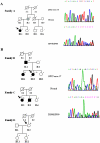Arrhythmogenic right ventricular dysplasia/cardiomyopathy associated with mutations in the desmosomal gene desmocollin-2
- PMID: 17033975
- PMCID: PMC1698574
- DOI: 10.1086/509122
Arrhythmogenic right ventricular dysplasia/cardiomyopathy associated with mutations in the desmosomal gene desmocollin-2
Abstract
Arrhythmogenic right ventricular dysplasia/cardiomyopathy (ARVD/C) is an inherited myocardial disorder associated with arrhythmias, heart failure, and sudden death. To date, mutations in four genes encoding major desmosomal proteins (plakoglobin, desmoplakin, plakophilin-2, and desmoglein-2) have been implicated in the pathogenesis of ARVD/C. We screened 77 probands with ARVD/C for mutations in desmocollin-2 (DSC2), a gene coding for a desmosomal cadherin. Two heterozygous mutations--a deletion and an insertion--were identified in four probands. Both mutations result in frameshifts and premature truncation of the desmocollin-2 protein. For the first time, we have identified mutations in desmocollin-2 in patients with ARVD/C, a finding that is consistent with the hypothesis that ARVD/C is a disease of the desmosome.
Figures


References
Web Resources
-
- GenBank, http://www.ncbi.nlm.nih.gov/Genbank/ (for DSC2a [accession number NM_024422] and DSC2b [accession number NM_004949])
-
- Online Mendelian Inheritance in Man (OMIM), http://www.ncbi.nlm.nih.gov/Omim/ (for ARVD/C) - PubMed
References
-
- Marcus FI, Fontaine GH, Guiraudon G, Frank R, Laurenceau JL, Malergue C, Grosgogeat Y (1982) Right ventricular dysplasia: a report of 24 adult cases. Circulation 65:384–398 - PubMed
-
- Corrado D, Fontaine G, Marcus FI, McKenna WJ, Nava A, Thiene G, Wichter T, Study Group on Arrhythmogenic Right Ventricular Dysplasia/Cardiomyopathy of the Working Groups on Myocardial and Pericardial Disease and Arrhythmias of the European Society of Cardiology and of the Scientific Council on Cardiomyopathies of the World Heart Federation (2000) Arrhythmogenic right ventricular cardiomyopathy: need for an international registry. Circulation 101:E101–E106 - PubMed
Publication types
MeSH terms
Substances
Associated data
- Actions
- Actions
- Actions
LinkOut - more resources
Full Text Sources
Medical
Molecular Biology Databases

